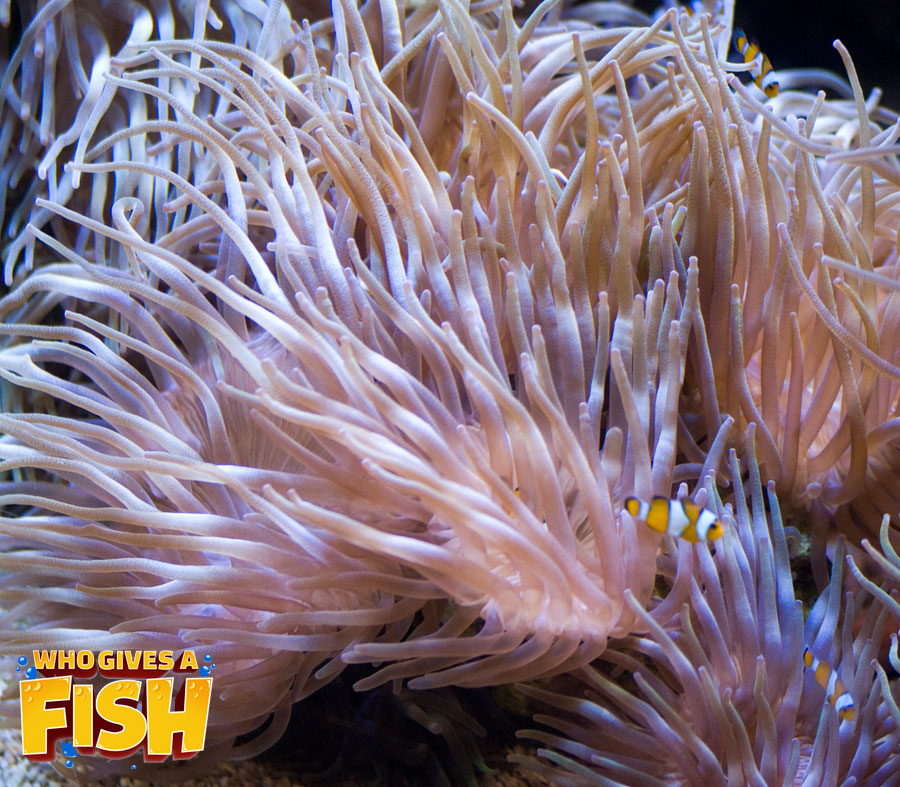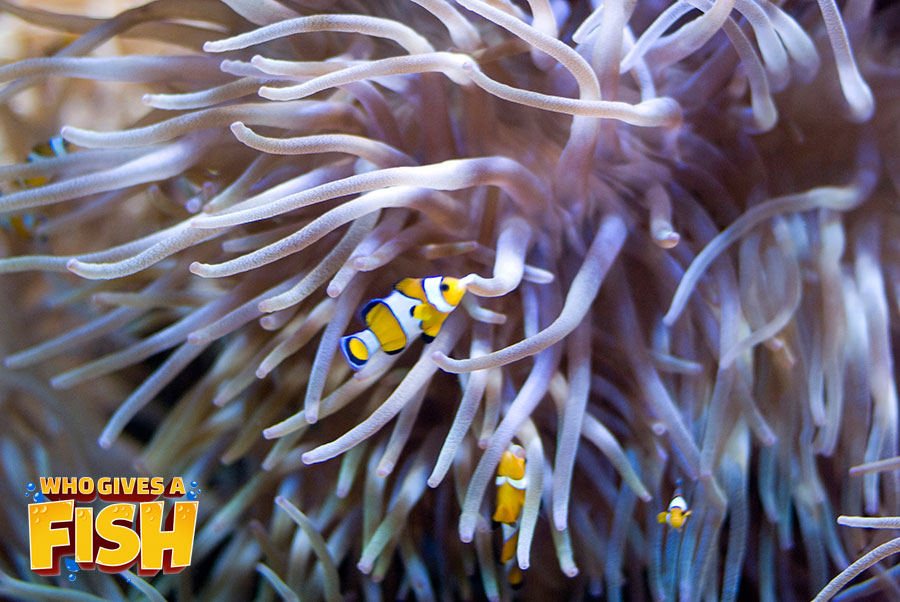Long Tentacle Anemone
The Long Tentacle Anemone, Macrodactyla doreensis, is also known as the Corkscrew Anemone. It’s a very nice, large growing anemone with the ability to reach up to 19” (48 cm). It has a brownish/red – orange coloring with some very distinct white spots seen on its foot. Many people place this coral low in the tank for this reason.
- Experience Level: Advanced
- Hardiness: Sensitive
- Minimum Tank Size: 100 gal (380 L)
- Lighting Needs: Moderate to high
- Temperature: 72° – 82° F (22.2° – 27.8° C)
- Gravity: 1.023 – 1.025
Table of Contents
Introduction
Aquarium Setup
Difficulty
Feeding
Breeding
Social
It does well with bright lighting, some fine substrates of sand or mud and mature reef. Ensure you have at least 4” of substrate or even deeper. Crushed coral is not recommended as the anemone can lacerate its foot.
As seen in the Bubble Tip Anemones, these Long Tentacles Anemones don’t always house Clownfish. However, they will on occasion form symbiotic relationships with them. If housing in a tank, don’t expect the relationship to be guaranteed as its fairly low chances. Regardless, they are a beautiful anemone on their own.
This anemone has venomous cells or nematocysts in their tentacles, which are used for both capturing food and also stinging and deflecting any threats or attacks from predators or other corals. Some of their predators include predator sea stars, some butterfly fish and some angelfish. Like other anemones, if it is mobile a lot and not settled, it means it’s not happy.
The Long Tentacle anemone is also known as the Snaky Sea Anemone, Red Base Anemone, Sand Anemone, Corkscrew Long Tentacled Anemone and the Corkscrew Anemone. When you are purchasing one of these, ensure you are not buying a bleached one or one that has been artificially colored. Bleaching can be fatal as it will purge all of the fake coloring before turning back to its original color of tan or brown.
This anemone can be described as having a soft spongy body that can be tube shaped as well. Its pedal column has a sticky foot that as is able to adhere to different surface types. This foot will also allow them to be mobile in order to find the ideal spot. Its color is brown, reddish brown-orange and will have white spots on its foot.
Their tentacles are spaced further apart than that of other similar anemones, with these surface tentacles surrounding a mouth or oral disc in the center. Tentacles will be white with purple, tan, pinkish or pink tips. These tentacles will either be a basic shape, corkscrew or striated pattern.
Their mouth or oral disc should be closed tightly and only open when hungry. Open, gaping mouths are a big sign of ill health. The Long Tentacle Anemone will take food in and expel waste from the same hole. Some anemones will be found with Acrorhagi which are smaller tentacles found in the underside of the mouth and will be exposed when the anemone is closed up.
Aquarium Setup
A sand only substrate, typical live rock/reef setup is what is required for this anemone. You should have at least 1 foot in diameter of mud or sand for them to settle in. The anemone will extend its foot through the sand and attach itself to a hard surface. Once this is done, it will stay here if it feels comfortable, if not it will begin to move around the tank in search of a better spot. If housing any anemones, ensure all of your pumps are covered as they are known to get caught up in them during walkabouts.
Long Tentacle Anemone Aquarium and Parameter Checklist
- Minimum Tank Size: 100 gal (380 L)
- Lighting Needs: Moderate to high
- Temperature: 72° – 82° F (22.2° – 27.8° C)
- Specific gravity: 1.023 – 1.025
- Alkalinity Levels: 3.5 – 4.8 MEQ/L (8 – 11 dKh)
- Calcium: 380 – 430 ppm
- Phosphates: 0 (Avoid Phosphates)
- Magnesium Levels: 1200 – 1350
- Strontium Levels: 8 – 10
- Water Movement: Low
- Tank Region: Bottom
Difficulty
This coral is known to be quite difficult to look after as they have high lighting requirements and need to be kept in a large enough tank to support their potential size. Adding them to a new tank will see them perish, so a tank of at least 1 years maturity is a minimum.
When choosing a Long Tentacle Anemone to purchase, ensure they hold a good color and their mouth is not open and gaping and the foot and tentacles are sticky when you touch them. Ideally, they should be already attached to something. If possible, inspect the foot for any damage that can come from being pulled off the rocks.
If moving from one aquarium to another during purchase, use a thin blunt object to gently wiggle under the foot. A credit card is good or a plastic spoon. Slowly nudge it away from the glass and massage its foot at the same time. If it is already attached to a rock, purchase the whole rock with it and take it home. If not, gently wiggle the rock upside down in front (but not directly) of a water pump and gently tickle its foot.
Feeding
The Long Tentacle Anemone is carnivores in the wild and is well equipped for such a diet. They are well equipped with nutritional alternatives as well to ensure their health. They will receive nutrition on a daily basis from their zooxanthellae which lives within their tissue. They also have venomous cells or nematocysts in their tentacles which are used to sting and capture prey.
They have the ability to absorb nutrients from the water and will also consume waste such as that from Clownfish. They do not rely on Clownfish to feed them but will accept any chucks of food that they do take them.
You can feed your anemone with chopped fresh fish, mussels, krill, shrimp and silversides as well as frozen carnivore preparations.
If Clownfish are hosted by your anemone, do not rely on them to feed your anemone. They often will prioritize themselves and not feed the anemone. You can offer them larger pieces of food that they may take down to the anemone or just consume themselves.
Breeding
Propagating this anemone is not suggested as so far, they never seem to recover from it. Anemones are able to multiply both sexually and asexually. One method is by using fission, which is when the Anemone will split in half from its foot or mouth and will form a clone of itself. The clone is in fact its own animal, similar to that of twins.
They can also reproduce by using female and male sex glands, or even locate another anemone that is the opposite sex. From this will come the production of ciliated planula larvae which will fall to the sea floor, eventually develop a pedal dish and start to grow into a whole new anemone.




Social
These anemones can and will move to where they ultimately feel like staying. Considering they are semi-aggressive, adding them to a reef tank should be done very cautiously.
If you plan to keep one of these Anemones, it would be wise to introduce it to your tank and let it settle in before introducing other expensive corals, especially corals that cannot move out of the way.
Back to top